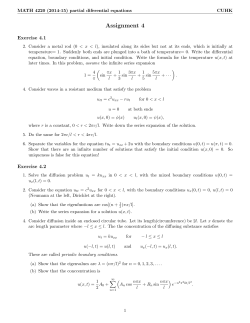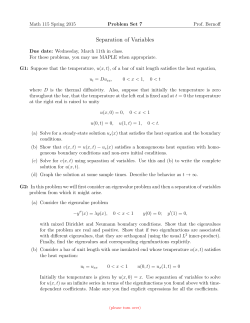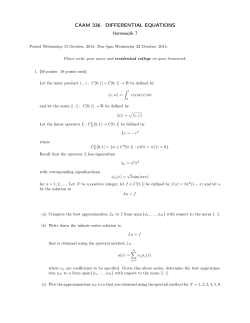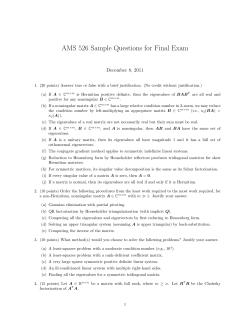
Math 126 - Fall 2014 - Homework 5 Hard copy due:
Math 126 - Fall 2014 - Homework 5 Hard copy due: Wednesday 10/15/2014 at 4:10pm Problem 1. Let Ω ⊂ Rd be an open, bounded smooth solution to ut − ∆u = 0 u(0, x) = f (x) ∇u(t, x) · n(x) = 0 Show that Z set with smooth boundary ∂Ω. Suppose u is a (t, x) ∈ (0, ∞) × Ω, x∈Ω x ∈ ∂Ω. Z u(t, x) dx ≡ Ω f (x) dx. Ω Problem 2. Let Ω ⊂ Rd be an open, bounded set with smooth boundary. Consider the eigenvalue problem −∆q(x) = λq(x), q:Ω→C with either Dirichlet or Neumann boundary conditions, that is, q(x) = 0 for x ∈ ∂Ω ∇q(x) · n(x) = 0 for x ∈ ∂Ω. or (i) Show that all eigenvalues are real. (ii) Show that for any eigenvalue we can find a real-valued eigenfunction. (iii) Suppose that q1 is an eigenfunction with eigenvalue λ1 and q2 is an eigenfunction with eigenvalue λ2 . Show that if λ1 6= λ2 then q1 and q2 are orthogonal, that is, Z q1 (x)q2 (x) dx = 0. Ω Problem 3. Consider the eigenvalue problem with homogeneous Dirichlet boundary conditions: −q 00 (x) = λq(x), x ∈ (0, L) q(0) = q(L) = 0. (i) Show that 0 is not an eigenvalue. (ii) Show that there are no negative eigenvalues. (iii) Find the eigenvalues and associated eigenfunctions. Problem 4. Consider the eigenvalue problem with homogeneous Neumann boundary conditions: −q 00 (x) = λq(x), x ∈ (0, L) q 0 (0) = q 0 (L) = 0. (i) Show that there are no negative eigenvalues. (ii) Find the eigenvalues and associated eigenfunctions. Problem 5. Suppose that for any smooth F : [−L, L] → C satisfying F (L) = F (−L) we can write F (x) = ∞ X cn e inπ x L for some cn ∈ C. n=−∞ (i) Show that if f : (0, L) → R is smooth and satisfies f (0) = f (L) = 0 then we can write f (x) = ∞ X an sin( nπ L x) for some an ∈ R. n=1 (ii) Show that if f : (0, L) → R is smooth and satisfies f 0 (0) = f 0 (L) = 0 then we can write f (x) = ∞ X bn cos( nπ L x) n=0 1 for some bn ∈ R. 2 Hints. To show that a number z is real, it suffices to show z = z. For problem 2, show that if f and g are a pair of functions satisfying either of the boundary conditions then Z Z − ∆f (x)g(x) dx = − f (x)∆g(x) dx. Ω Ω For problem 5 you will need to use the identity eiθ = cos θ + i sin θ. Also, follow the hints I gave in class.
© Copyright 2025





















